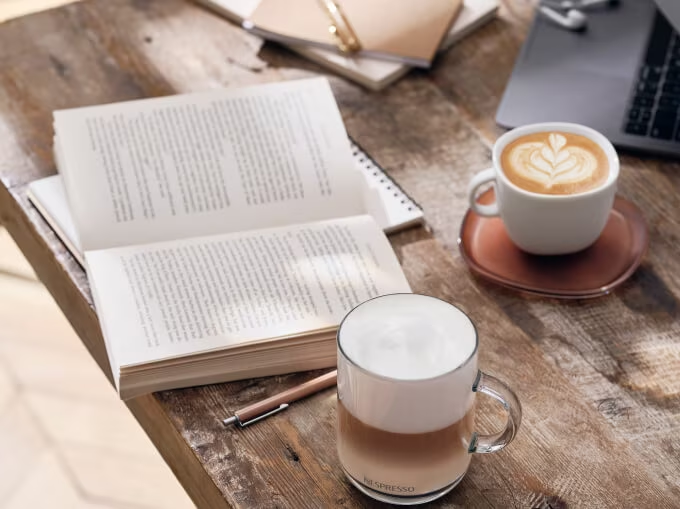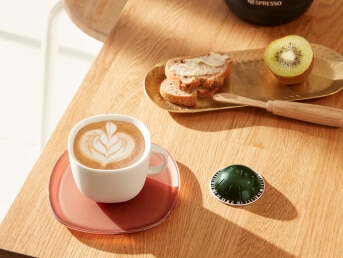Header
A Guide to Cappuccino vs. Latte
The cappuccino and the latte are two beloved espresso-based drinks made with milk that each offer a different taste and a unique coffee experience. Their widespread popularity is a testament to the love for coffee that transcends continents and cultures.


At their core, both the cappuccino and latte share common DNA and a similar amount of caffeine, making them the go-to choice for a morning jumpstart or an afternoon pick-me-up. But beyond these similarities, each drink carries its own identity that can be distinguished by subtle differences in preparation, presentation, and taste.
In this article, you’ll get everything you need to learn about the differences between a cappuccino and a latte to help determine which drink is more ideal for your palette.
The main differences
Understanding the differences between a cappuccino and a latte can help you choose the coffee drink that best suits your taste. While they might look similar, their key differences lie in the ingredients and how they're put together. It's worth noting that, by definition, a latte is larger than a cappuccino, with more milk in its composition.
Ingredients and Ratios

Ingredients in a Cappuccino
- The bottom layer is a shot of espresso
- The middle layer is an equal amount of steamed milk
- The top layer is an equal amount of frothed milk or foam
So, if you were to measure it out, a cappuccino is a 1:1:1 ratio. This means that in every sip, you'll get a balanced taste of strong espresso, creamy milk, and frothy milk foam.

Ingredients in a Latte
- One part espresso
- Three parts steamed milk
On top, you'll usually find a small amount of foam which is enough to leave a creamy texture on your lips. This gives a latte a milkier and creamier taste compared to a cappuccino. If you're someone who prefers a less strong or intense coffee flavour, a latte might be your go-to coffee drink.

Milk Texture
The way milk is prepared and added to cappuccinos and lattes play a huge role in differentiating the two drinks. It’s all about texture, and how it can change the entire feel and taste of a drink.
Cappuccinos: In a cappuccino, the milk is steamed but also frothed to create a thick, airy foam by using a milk frother. This frothed milk gives the cappuccino its signature rich and creamy texture. When you sip a cappuccino, you’ll first taste the frothy, light-as-air milk foam, followed by the perfect combination of espresso and steamed milk.
Lattes: Lattes have a smoother texture due to it having more steamed milk and just a little bit of foam on top. So, instead of a substantial layer of foam, like in a cappuccino, a latte has just a thin layer of foam that blends in with the steamed milk. This makes the latte creamier and gives it a velvety, smooth finish.
Preparation
The way a coffee drink is prepared can greatly affect its taste and texture, and this is especially true when comparing cappuccinos and lattes.
Preparing a Cappuccino
The result is a cappuccino with a balanced taste of strong espresso, creamy milk, and frothy foam.

Preparing a Latte

Serving Size and Style
The size and style of the cup or glass in which your coffee is served isn't just for aesthetics. It also impacts the balance of flavours in your drink and can even change your overall coffee experience. Cappuccinos and lattes are a perfect example of how serving size and style can make a difference.
Serving a Cappuccino:Cappuccinos are traditionally served in smaller cups, typically around 150-180 mL in size. By using a smaller cup, these proportions are kept in balance. Each sip of a cappuccino gives you a perfect blend of its ingredients. With that said, while the cup might be small, a cappuccino comes packed with a balanced flavour that can be savoured slowly.
Serving a Latte:Lattes, on the other hand, are often served in larger glasses, usually holding around 240-300 mL. This larger size is needed to accommodate the extra milk that makes a latte, a latte. Because lattes have more steamed milk and less foam, a larger glass helps keep the balance of espresso and milk.
Calories
The amount of calories in your coffee mainly comes from the milk and any added sugars or flavourings.
Lattes: A latte, which contains more milk than a cappuccino, tends to have more calories. To have more precision, you might need to refer to the nutrient's description of your favorite milk brand. A standard latte made with whole milk can have around 130-170 calories. This number varies depending on the type of milk you use, as well as the types of flavored sweeteners you add to the drink.
Cappucinos: A cappuccino, which has equal parts of espresso, steamed milk, and foam, usually has fewer calories. A standard cappuccino can range from 80-120 calories, depending on the type of milk used. The thick layer of foam adds volume to the drink without adding a lot of calories, which keeps the calorie count lower than in a milk-heavy latte.
If you're curious about the calories in your coffee, the amount is very minimal. If you're watching your calories, a cappuccino might be a lower-calorie option. However, it's still important to take into account any extras you might add, like sugar or flavored syrups, as these can significantly increase the number of calories in your coffee.
Taste Profile
Cappuccinos and lattes differentiate in taste and robust flavour based on the ratio of ingredients that make up each drink.
The Taste of a Cappuccino

The Taste of a Latte

A History of the Cappuccino and Latte
Born in the heart of Italy, both beverages have left their mark on the global coffee culture while doing so in unique ways. Coffee has a rich and storied history, and the origins of the cappuccino and latte are no different. Both drinks have deep roots that reach back centuries, spanning different cultures and evolving over time.
The Origin of The Cappuccino

The Origin of The Latte

Table Comparison Between Cappuccinos and Lattes
Both cappuccinos and lattes hold a cherished place in coffee culture. Choosing between a cappuccino and a latte is solely personal preference as there is no real comparison when identifying which drink is “better”.
- For those drawn to a robust, balanced blend of coffee and cream, a cappuccino could be an ideal choice.
- For a milder, milkier and creamier drink, a latte could be a perfect match for those who prefer softer flavours.
Below is a side-by-side comparison of the two drinks in terms of the different elements covered in this article:
One of the exciting aspects of coffee culture is the ability to personalize each drink. Nespresso products embody the spirit of customization, encouraging people to complement their cappuccinos and lattes with additional ingredients that suit each individual preference. It's important to note that using alternative milks, such as plant-based milk, will drastically change the taste of both a latte and a cappuccino. The use of syrups, alternative milks, adjustable temperatures, and a variety of coffee beans can all be seamlessly integrated into both beverages with Nespresso.
Nespresso products provide more than just coffee; They offer an experience that simulates a cafe-like ambiance from the comfort of your own home. With Nespresso, coffee lovers become creators, diving deep into the world of coffee and crafting the perfect cup. To experience cappuccinos and lattes in different ways, visit our recipe page to explore more elevated versions of coffee drinks.
Some of the most popular latte recipes available are:
Some of the most popular cappuccino recipes available are:
Whether the preference is a cappuccino or a latte, Nespresso always offers a unique coffee experience. Get all the tools needed to savour, explore, and perfect your coffee today.
If you'd like to learn more about different coffee types, check out our article here.



